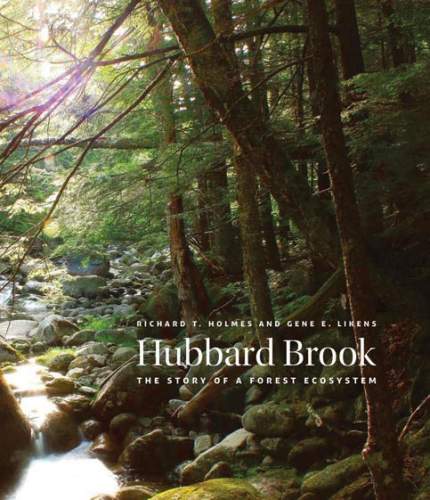by Richard T. Holmes and Gene E. Likens
Yale University Press, 2016
New Hampshire’s Hubbard Brook Research Forest is a testament to how much can be gained from an enduring commitment to scientific research. Over the past 50 years, hundreds of researchers and scores of universities and other organizations have worked in Hubbard Brook, making it one of the most studied tracts on the planet. Focusing on the practical uses of science, this distinguished White Mountain living laboratory has been contributing to our understanding of the northern hardwood forest and the larger world for more than half a century. Researchers working there have documented the past to better explain the present, and they are documenting the present to better anticipate the future.
In Hubbard Brook: The Story of a Forest Ecosystem, Richard T. Holmes and Gene E. Likens provide an engaging overview of the Hubbard Brook watershed and highlight some of the contributions to our understanding of ecosystems, the development of environmental policy, and the improvement of natural-resources management made by researchers working there. Over the decades, scientists using Hubbard Brook as their lab have played major roles in researching acid rain, improving forest harvesting practices, and understanding the causes of declines in bird populations.
The book highlights a few of the many projects and studies done in Hubbard Brook and its tributaries; the authors precisely describe the forest, streams, vegetation, and wildlife, making them a part of the overall education. As I read the book, I looked forward to returning to the woods with a richer understanding of where I was walking and a deeper appreciation for everything that’s going on in our woods and streams. Throughout the book, Holmes and Likens show how Hubbard Brook scientists have methodically studied the interaction of different elements of the ecosystem. It’s this type of research that has shown us that no aspect of the environment exists or functions in isolation. Unable to study an entire “dauntingly complex” ecosystem, Hubbard Brook scientists have studied clearly-defined units that provided details and insights into how parts of the ecosystem affect each other. The authors use a medical analogy to explain this: “The chemistry of stream water could be used to diagnose a watershed ecosystem in the same way that a physician uses the chemistry found in blood or urine to diagnose the health of a human patient.”
While the past 50 years of research provide most of the material for the book, Holmes and Likens look both farther back and into the future. They briefly track the development of the current Hubbard Brook since the melting of the glaciers 14,000 years ago and the stages of human impact in the valley since the arrival of Europeans only 250 years ago. They discuss how the effects of major weather events and human activity can still be visible even 80 or 100 years on. The final sections look ahead to what the next 50 years may look like, with the clear implication that the changes being documented there by researchers today aren’t limited to Hubbard Brook. While the first part of the book feels like a guided walk in the woods and the entire book emphasizes that change is constant and omnipresent, the last part reinforces the reality of climate change.
Clearly written and timely, Hubbard Brook is targeted toward readers who appreciate science and want to look at a Northeastern forest through a scientist’s eyes. It has excellent graphics, statistics, footnotes, and an extensive bibliography.


